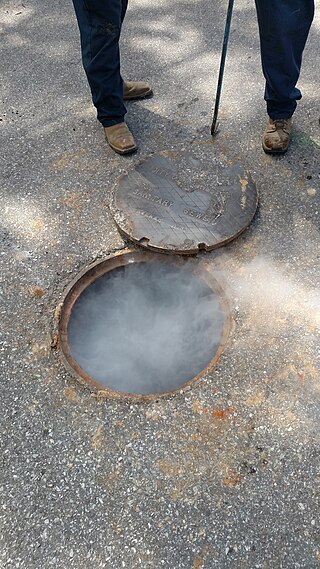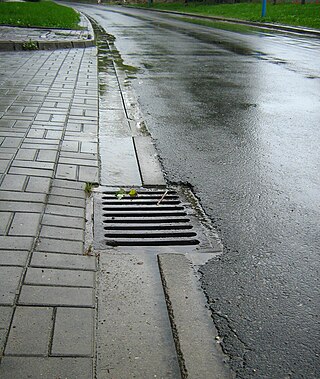An autonomous building is a building designed to be operated independently from infrastructural support services such as the electric power grid, gas grid, municipal water systems, sewage treatment systems, storm drains, communication services, and in some cases, public roads.

Flatulence, in humans, is the expulsion of gas from the intestines via the anus, commonly referred to as farting, tooting, or passing gas. "Flatus" is the medical word for gas generated in the stomach or bowels. A proportion of intestinal gas may be swallowed environmental air, and hence flatus is not entirely generated in the stomach or bowels. The scientific study of this area of medicine is termed flatology.

Plumbing is any system that conveys fluids for a wide range of applications. Plumbing uses pipes, valves, plumbing fixtures, tanks, and other apparatuses to convey fluids. Heating and cooling (HVAC), waste removal, and potable water delivery are among the most common uses for plumbing, but it is not limited to these applications. The word derives from the Latin for lead, plumbum, as the first effective pipes used in the Roman era were lead pipes.

Smoke testing refers to various classes of tests of systems, usually intended to determine whether they are ready for more robust testing. The expression probably was first used in plumbing in referring to tests for the detection of cracks, leaks or breaks in closed systems of pipes.

Hydrogen sulfide is a chemical compound with the formula H2S. It is a colorless chalcogen-hydride gas, and is poisonous, corrosive, and flammable, with trace amounts in ambient atmosphere having a characteristic foul odor of rotten eggs. The underground mine gas term for foul-smelling hydrogen sulfide-rich gas mixtures is stinkdamp. Swedish chemist Carl Wilhelm Scheele is credited with having discovered the chemical composition of purified hydrogen sulfide in 1777. The British English spelling of this compound is hydrogen sulphide, a spelling no longer recommended by the Royal Society of Chemistry or the International Union of Pure and Applied Chemistry.

Sewerage is the infrastructure that conveys sewage or surface runoff using sewers. It encompasses components such as receiving drains, manholes, pumping stations, storm overflows, and screening chambers of the combined sewer or sanitary sewer. Sewerage ends at the entry to a sewage treatment plant or at the point of discharge into the environment. It is the system of pipes, chambers, manholes, etc. that conveys the sewage or storm water.

A septic tank is an underground chamber made of concrete, fiberglass, or plastic through which domestic wastewater (sewage) flows for basic sewage treatment. Settling and anaerobic digestion processes reduce solids and organics, but the treatment efficiency is only moderate. Septic tank systems are a type of simple onsite sewage facility. They can be used in areas that are not connected to a sewerage system, such as rural areas. The treated liquid effluent is commonly disposed in a septic drain field, which provides further treatment. Nonetheless, groundwater pollution may occur and can be a problem.

A plumber is a tradesperson who specializes in installing and maintaining systems used for potable (drinking) water, and for sewage and drainage in plumbing systems.

A sanitary sewer is an underground pipe or tunnel system for transporting sewage from houses and commercial buildings to a sewage treatment plant or disposal. Sanitary sewers are a type of gravity sewer and are part of an overall system called a "sewage system" or sewerage. Sanitary sewers serving industrial areas may also carry industrial wastewater. In municipalities served by sanitary sewers, separate storm drains may convey surface runoff directly to surface waters. An advantage of sanitary sewer systems is that they avoid combined sewer overflows. Sanitary sewers are typically much smaller in diameter than combined sewers which also transport urban runoff. Backups of raw sewage can occur if excessive stormwater inflow or groundwater infiltration occurs due to leaking joints, defective pipes etc. in aging infrastructure.
A drain cleaner or opener is a person, device or product unblocking sewer pipes or clogged wastewater drains. The term usually refers to a chemical or mechanical utensil such as a commercial chemical product, plumber's snake, drain auger or toilet plunger. Occasionally, it is applied to a plumber or another individual who performs the drain cleaning and hygiene.

A storm drain, storm sewer, surface water drain/sewer, or stormwater drain is infrastructure designed to drain excess rain and ground water from impervious surfaces such as paved streets, car parks, parking lots, footpaths, sidewalks, and roofs. Storm drains vary in design from small residential dry wells to large municipal systems.
A plumbing fixture is an exchangeable device which can be connected to a plumbing system to deliver and drain water.

In modern plumbing, a drain-waste-vent is a system that allows air to enter the plumbing system to maintain proper air pressure to enable the removal of sewage and greywater from a dwelling. Drain refers to water produced at fixtures such as sinks, and showers; waste refers to water from toilets. As the water runs down, proper venting is required to allow water to flow freely, and avoid a vacuum from being created. As the water runs down air must be allowed into the waste pipe either through a roof vent (external), or an internal vent.

A leachate is any liquid that, in the course of passing through matter, extracts soluble or suspended solids, or any other component of the material through which it has passed.
An anaerobic lagoon or manure lagoon is a man-made outdoor earthen basin filled with animal waste that undergoes anaerobic respiration as part of a system designed to manage and treat refuse created by concentrated animal feeding operations (CAFOs). Anaerobic lagoons are created from a manure slurry, which is washed out from underneath the animal pens and then piped into the lagoon. Sometimes the slurry is placed in an intermediate holding tank under or next to the barns before it is deposited in a lagoon. Once in the lagoon, the manure settles into two layers: a solid or sludge layer and a liquid layer. The manure then undergoes the process of anaerobic respiration, whereby the volatile organic compounds are converted into carbon dioxide and methane. Anaerobic lagoons are usually used to pretreat high strength industrial wastewaters and municipal wastewaters. This allows for preliminary sedimentation of suspended solids as a pretreatment process.
Microbial corrosion, also called microbiologically influenced corrosion (MIC), microbially induced corrosion (MIC) or biocorrosion, is "corrosion affected by the presence or activity (or both) of microorganisms in biofilms on the surface of the corroding material." This corroding material can be either a metal (such as steel or aluminum alloys) or a nonmetal (such as concrete or glass).

In plumbing, a trap is a U-shaped portion of pipe designed to trap liquid or gas to prevent unwanted flow; most notably sewer gases from entering buildings while allowing waste materials to pass through. In oil refineries, traps are used to prevent hydrocarbons and other dangerous gases and chemical fumes from escaping through drains. In heating systems, the same feature is used to prevent thermo-siphoning which would allow heat to escape to locations where it is not wanted. Similarly, some pressure gauges are connected to systems using U bends to maintain a local gas while the system uses liquid. For decorative effect, they can be disguised as complete loops of pipe, creating more than one U for added efficacy.
Biogenic sulfide corrosion is a bacterially mediated process of forming hydrogen sulfide gas and the subsequent conversion to sulfuric acid that attacks concrete and steel within wastewater environments. The hydrogen sulfide gas is biochemically oxidized in the presence of moisture to form sulfuric acid. The effect of sulfuric acid on concrete and steel surfaces exposed to severe wastewater environments can be devastating. In the USA alone, corrosion is causing sewer asset losses estimated at $14 billion per year. This cost is expected to increase as the aging infrastructure continues to fail.

A grease trap is a plumbing device designed to intercept most greases and solids before they enter a wastewater disposal system. Common wastewater contains small amounts of oils which enter into septic tanks and treatment facilities to form a floating scum layer. This scum layer is very slowly digested and broken down by microorganisms in the anaerobic digestion process. Large amounts of oil from food preparation in restaurants can overwhelm a septic tank or treatment facility, causing the release of untreated sewage into the environment. High-viscosity fats and cooking grease such as lard solidify when cooled, and can combine with other disposed solids to block drain pipes.

Manure management refers to capture, storage, treatment, and utilization of animal manures in an environmentally sustainable manner. It can be retained in various holding facilities. Animal manure can occur in a liquid, slurry, or solid form. It is utilized by distribution on fields in amounts that enrich soils without causing water pollution or unacceptably high levels of nutrient enrichment. Manure management is a component of nutrient management.















